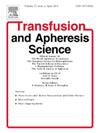血浆置换的地方
IF 1.2
4区 医学
Q4 HEMATOLOGY
引用次数: 0
摘要
在血浆来源医疗产品的生产中,对血浆源的需求日益增加,这一问题最近在欧洲引起了注意,并引发了各种行动。生产和利用之间的差异提出了需要在国际社会讨论的伦理和医学问题。应鼓励无偿自愿捐助者的捐助,一些国家已在国家血浆战略文件中处理了这个问题。除此之外,血液中心在减少细胞血液制品使用的同时,也增加了血浆分离活动,以努力增加血浆捐献和保留有价值的献血者。在奥斯陆血液中心,我们鼓励我们的全血献血者也捐献血浆,通过这种方式,我们使他们保持活跃,并为紧急情况下的全血捐献做好准备。在这篇评论中,我描述了在当前框架内增加浆质体数量所必需的思想转变。本文章由计算机程序翻译,如有差异,请以英文原文为准。
A place for plasmapheresis
The increased need for source plasma in the production of plasma-derived medical products has received attention and elicited diverse actions in Europe lately. The discrepancy between production and utilization poses ethical as well as medical questions to be discussed in the international community. The contribution of non-remunerated voluntary donors should be encouraged, and several nations have addressed the problem in national plasma strategy documents. Independent of this, blood centers have increased their plasmapheresis activity in efforts to increase plasma donation and retain valuable donors, in parallel with decreased use of cellular blood products. In Oslo Blood Center we have encouraged our whole blood donors to also donate plasma, by which we keep them active and prepared for whole blood donation if an urgent situation rises. In this commentary I describe the change of mind set necessary to increase the number of plasmaphereses within the current frameworks.
求助全文
通过发布文献求助,成功后即可免费获取论文全文。
去求助
来源期刊
CiteScore
3.60
自引率
5.30%
发文量
181
审稿时长
42 days
期刊介绍:
Transfusion and Apheresis Science brings comprehensive and up-to-date information to physicians and health care professionals involved in the rapidly changing fields of transfusion medicine, hemostasis and apheresis. The journal presents original articles relating to scientific and clinical studies in the areas of immunohematology, transfusion practice, bleeding and thrombotic disorders and both therapeutic and donor apheresis including hematopoietic stem cells. Topics covered include the collection and processing of blood, compatibility testing and guidelines for the use of blood products, as well as screening for and transmission of blood-borne diseases. All areas of apheresis - therapeutic and collection - are also addressed. We would like to specifically encourage allied health professionals in this area to submit manuscripts that relate to improved patient and donor care, technical aspects and educational issues.
Transfusion and Apheresis Science features a "Theme" section which includes, in each issue, a group of papers designed to review a specific topic of current importance in transfusion and hemostasis for the discussion of topical issues specific to apheresis and focuses on the operators'' viewpoint. Another section is "What''s Happening" which provides informal reporting of activities in the field. In addition, brief case reports and Letters to the Editor, as well as reviews of meetings and events of general interest, and a listing of recent patents make the journal a complete source of information for practitioners of transfusion, hemostasis and apheresis science. Immediate dissemination of important information is ensured by the commitment of Transfusion and Apheresis Science to rapid publication of both symposia and submitted papers.

 求助内容:
求助内容: 应助结果提醒方式:
应助结果提醒方式:


